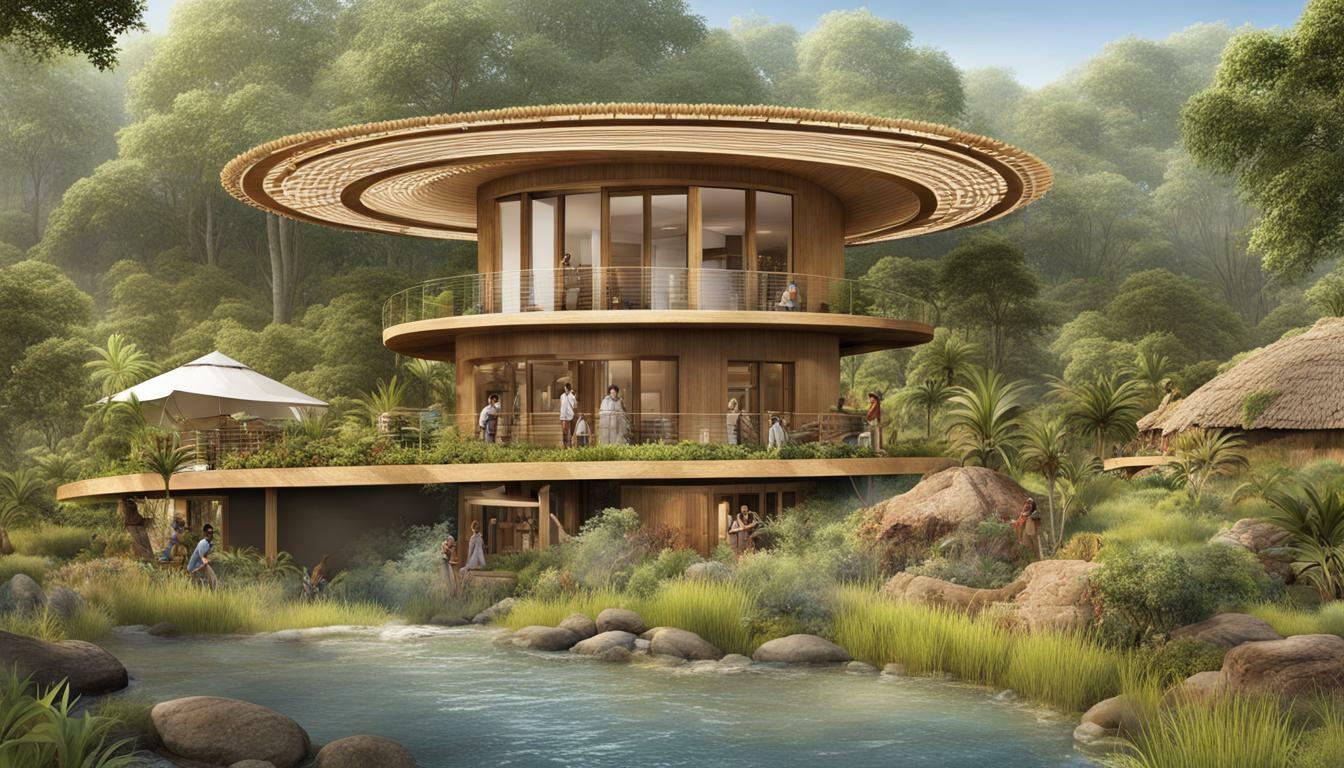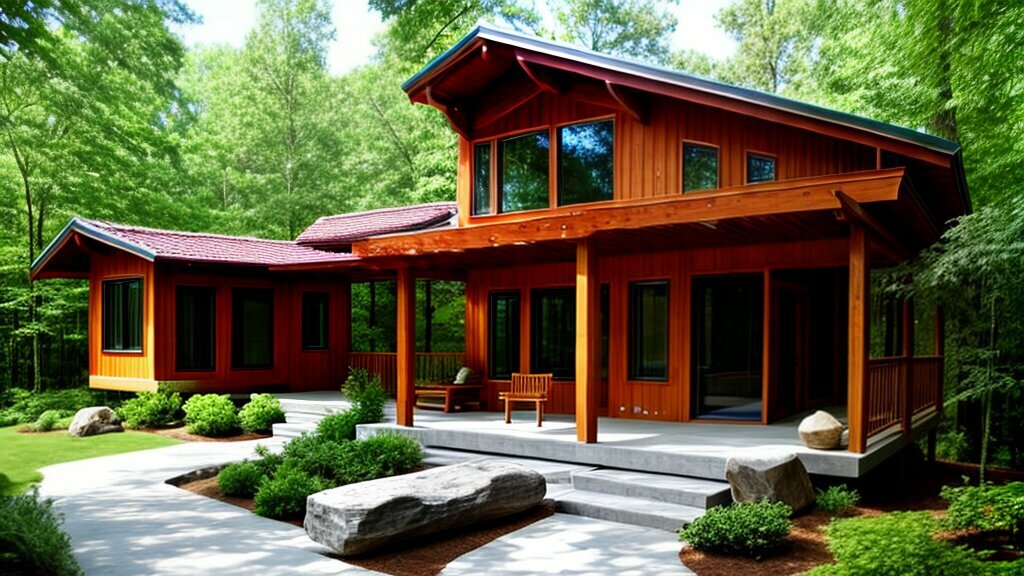Colonial Impact and Indigenous Architecture: Tracing the Journey of Design Resilience
Indigenous Architecture has a rich history steeped in centuries of tradition and culture. However, with the arrival of colonial powers and their imposition of colonization architecture, indigenous building traditions were challenged. This section explores the impact of colonialism on Indigenous Architecture, highlighting the importance of tracing the journey of design resilience that has emerged as a result.
Indigenous Architecture is a reflection of cultural heritage, and its preservation is vital to the identity of indigenous communities. Colonization architecture, however, often disregarded traditional indigenous design principles, replacing them with styles and techniques imposed by colonial powers. Understanding the colonial impact on Indigenous Architecture is essential to appreciating the resilience of indigenous building traditions throughout history.
Key Takeaways:
- Colonization architecture had a significant impact on indigenous building traditions, replacing them with European styles and techniques.
- Preserving indigenous cultural heritage is essential to the identity of indigenous communities.
- Understanding colonial legacies is crucial to appreciating the journey of design resilience that has emerged in Indigenous Architecture.
Understanding Colonial Impact and Indigenous Architecture
Indigenous Architecture has a rich history that is deeply intertwined with cultural heritage and traditional building techniques. However, the arrival of European colonial powers had a profound impact on the architectural landscape of many indigenous communities. The introduction of colonization architecture and associated building techniques resulted in significant changes to indigenous building traditions and still resonates in the present day.
The colonial impact on indigenous cultural heritage cannot be understated. The imposition of colonial legacies resulted in the erasure of many indigenous building techniques and the loss of architectural heritage. While some aspects of indigenous architecture were incorporated into colonial building styles, the overall effect was to devalue the fundamental principles of traditional indigenous design.
During this period, indigenous communities were often subjected to forced labor and robbed of their cultural identity. This resulted in the suppression of traditional building techniques and the promotion of colonial building styles. Architects were encouraged to adopt Western styles and techniques, resulting in the marginalization of indigenous communities and their architectural heritage.
| Colonial Impact | Indigenous Cultural Heritage | Colonization Architecture | Colonial Legacies |
|---|---|---|---|
| The arrival of European colonial powers | Deeply intertwined with cultural heritage and traditional building techniques | The result of colonial powers imposing their own building techniques on indigenous communities | The lasting effects of colonization on indigenous building traditions |
| Profound impact on the architectural landscape | Significant changes to indigenous building traditions | Devalued the fundamental principles of traditional indigenous design | Resulted in the suppression and loss of architectural heritage |
| Forced labor and suppression of traditional building techniques | Promotion of Western building styles and techniques | Marginalized indigenous communities and their architectural heritage | Challenge the lasting effects of colonialism on indigenous architecture |
Despite the challenges faced by indigenous communities, there has been a growing recognition of the importance of preserving architectural heritage and traditional building techniques. Efforts to promote decolonization in architecture have gained traction in recent years, with architects and designers working alongside indigenous communities to ensure that the fundamental principles of traditional indigenous design are respected and preserved for future generations.

The Transformation of Indigenous Architecture
In response to colonial impact, Indigenous Architecture has undergone a significant transformation over the years. The emergence of post-colonial architecture marked a new era of design that sought to blend contemporary influences with traditional indigenous architecture.
Architectural heritage has played a crucial role in shaping the transformation of Indigenous Architecture. As indigenous communities strive to preserve their cultural identity, they have actively sought to incorporate architectural heritage into contemporary building designs. This has resulted in a unique fusion of modern and traditional indigenous design elements, giving rise to a new form of architecture that celebrates both cultural heritage and innovation.
Indigenous building traditions have also played a significant role in the transformation of Indigenous Architecture. These building traditions have evolved and adapted to new influences, while preserving their cultural authenticity. As a result, indigenous communities have been able to create spaces that reflect their values and aspirations.
The transformation of Indigenous Architecture has not been without its challenges, however. Colonial legacies have had a lasting impact on indigenous communities, and the preservation of architectural heritage and indigenous building traditions has been an ongoing struggle. However, by embracing their resilience and creativity, indigenous communities have been able to overcome these challenges and create a new form of architecture that reflects their cultural identity.

The transformation of Indigenous Architecture has not been without its critics. Some argue that the incorporation of contemporary influences has diluted the authenticity of traditional indigenous design. However, others see it as a necessary step towards decolonization and the promotion of indigenous cultural heritage.
Looking towards the future, it is clear that Indigenous Architecture will continue to evolve and adapt to new influences. The ongoing efforts to promote decolonization within the field will play a crucial role in shaping its future direction. The preservation of architectural heritage and indigenous building traditions will remain a priority, as indigenous communities strive to create spaces that reflect their cultural identity.
Decolonizing Indigenous Architecture
In recent years, there has been a growing movement towards decolonizing Indigenous Architecture. This involves challenging the dominant Western-centric narratives within the field and promoting the preservation and restoration of architectural heritage and indigenous cultural heritage.
Architects and designers are now recognizing the importance of incorporating traditional indigenous design principles into contemporary practices as a means of reclaiming cultural identity and fostering resilience. The goal is to create spaces that reflect the values and aspirations of indigenous communities, rather than imposing foreign architectural styles and techniques.
Decolonization also involves acknowledging and addressing the negative impact of colonization on indigenous building traditions and the architectural heritage of indigenous communities. This includes efforts to reclaim and restore buildings and structures that have been lost or damaged due to colonialism.
Overall, decolonizing Indigenous Architecture is essential for promoting cultural diversity and authenticity within the field. It is an ongoing process that requires continued efforts to challenge colonial legacies and promote the values and perspectives of indigenous communities.

“Decolonizing Indigenous Architecture is essential for promoting cultural diversity and authenticity within the field.”
Resilience in Traditional Indigenous Design
Despite the lasting effects of colonial impact on Indigenous Architecture, traditional indigenous design has maintained its resilience and significance. Indigenous building traditions have been passed down through generations and continue to shape the architectural landscape today. These building traditions not only reflect cultural values but also respond to environmental conditions and local resources, making them sustainable and practical.
Architectural heritage plays a crucial role in preserving traditional indigenous design and serves as a reminder of the history and culture of indigenous communities. It also provides a framework for contemporary indigenous architects to draw inspiration from and build upon.
The colonial impact on Indigenous Architecture, however, cannot be ignored. The introduction of colonial architecture styles and techniques disrupted indigenous building traditions and left a lasting legacy that continues to influence contemporary architecture today. Despite these challenges, indigenous architects and designers have found ways to adapt and incorporate new influences while maintaining cultural authenticity.

The resilience of traditional indigenous design is not only a reflection of the past but also a beacon for the future. As the world becomes more interconnected, there is an increasing awareness of the value of indigenous knowledge and the importance of preserving cultural identity. The continued promotion and preservation of traditional indigenous design will not only honour the past but also provide a framework for building sustainable and culturally relevant spaces for future generations.
Examples of Indigenous Architectural Resilience
Indigenous architectural resilience is evident in various parts of the world, with communities embracing traditional indigenous design principles while adapting to contemporary influences. The Inuit people of Canada have a long history of building igloos, which are dome-shaped structures made of snow. These structures are not only resilient to harsh weather conditions but are also highly sustainable, as they are made from locally available materials.
The traditional Maori meeting house, or wharenui, is another example of indigenous architectural resilience. These structures were designed to be adaptable to different environments while preserving cultural authenticity. Many wharenui have been refurbished to serve contemporary purposes while maintaining their traditional design principles.
| Image | Alt text |
|---|---|
 |
Traditional Indigenous Design Example |
The Tiwanaku culture in Bolivia also has a rich history of indigenous architectural resilience. The city of Tiwanaku was once a thriving urban center with monumental stone structures, including the Akapana pyramid, which stands over 17 meters tall. While many of these structures have been damaged or destroyed over time, efforts are being made to preserve those that remain and incorporate traditional Tiwanaku design principles into contemporary architecture.
In Australia, the Warlu Jilajaa Jumu (Seven Sisters) project is a prime example of architectural resilience. The project involved the construction of a new visitors center at a cultural site in the Western Desert, which incorporates traditional indigenous design principles with contemporary sustainability considerations. The center serves as a community hub and a symbol of cultural resilience in the face of colonial legacies.
These examples of indigenous architectural resilience demonstrate the ability of traditional indigenous design principles to adapt and evolve in response to changing environments and influences while preserving cultural identity. By incorporating these principles into contemporary architectural practices, we can challenge dominant colonial narratives and promote decolonization within the field of architecture.
Future Directions for Indigenous Architecture
Indigenous Architecture has a bright future ahead as more and more efforts are being made to promote decolonization within the field. The preservation of architectural heritage and indigenous building traditions is crucial for the creation of spaces that reflect the values and aspirations of indigenous communities.
One direction for the future of Indigenous Architecture is the incorporation of sustainable and eco-friendly practices. By embracing traditional knowledge and building techniques, architects can create buildings that are not only aesthetically pleasing but also environmentally conscious.
Another future direction is the integration of modern technologies and materials while maintaining respect for traditional design principles. The use of sustainable building materials and energy-efficient systems can help to reduce the impact of construction on the environment while also providing comfortable living spaces for indigenous communities.
Finally, the promotion of Indigenous Architecture as a distinct discipline within the field of architecture is an important step towards decolonization. Indigenous architects and designers can bring a unique perspective to the industry, one that is rooted in cultural identity and respect for the natural world.
Overall, the future of Indigenous Architecture is bright and full of potential. By continuing to honour architectural heritage and indigenous building traditions while embracing new techniques and technologies, the field can create spaces that reflect the diverse and vibrant cultures of indigenous communities.

Colonial Impact and Indigenous Architecture Conclusion
In conclusion, the impact of colonization on Indigenous Architecture cannot be denied. The introduction of colonial architecture styles and techniques had a significant impact on indigenous building traditions, and the preservation of architectural and cultural heritage remains a constant challenge. However, throughout history, we have seen the resilience and transformation of Indigenous Architecture, which has continuously adapted and evolved to incorporate contemporary influences while preserving cultural identity.
The concept of decolonization is essential in promoting the restoration and reclamation of architectural heritage and indigenous building traditions. It aims to challenge the dominant colonial narratives within the field of architecture and promote the values and aspirations of indigenous communities.
As we move towards the future, it is crucial to continue the ongoing efforts to support decolonization and preserve architectural heritage and indigenous building traditions. Indigenous Architecture has the potential to create spaces that reflect the unique cultural identities and values of indigenous communities, and it is essential to recognise and celebrate the significance of traditional indigenous design.
In summary, Indigenous Architecture has faced significant challenges in the past. However, by tracing the journey of design resilience, we can see how it has transformed and continues to adapt to create spaces that reflect the cultural identities of indigenous communities. By promoting decolonization, preserving architectural and cultural heritage, and celebrating traditional indigenous design, we can ensure that Indigenous Architecture continues to thrive into the future.
FAQ
Q: What is the impact of colonization on Indigenous Architecture?
A: Colonization has significantly influenced Indigenous Architecture. It introduced new architectural styles and techniques, which had both positive and negative effects on indigenous building traditions.
Q: How has Indigenous Architecture transformed over the years?
A: Indigenous Architecture has undergone transformation in response to colonial impact. It has seen the emergence of post-colonial architecture and the adaptation of indigenous building traditions to new influences while preserving cultural identity.
Q: What is decolonization in the context of Indigenous Architecture?
A: Decolonization in Indigenous Architecture involves reclaiming and restoring architectural heritage, promoting indigenous cultural heritage, and challenging dominant colonial narratives within the field.
Q: How does traditional indigenous design exhibit resilience?
A: Traditional indigenous design showcases resilience by withstanding the impacts of colonization. It continues to influence contemporary architectural practices and serves as a means of reclaiming cultural identity.
Q: Can you provide examples of indigenous architectural resilience?
A: There are numerous examples of indigenous architectural resilience worldwide. These projects embody traditional indigenous design principles while incorporating contemporary influences and challenging colonial legacies in architecture.
Q: What are the future directions for Indigenous Architecture?
A: The future of Indigenous Architecture involves promoting decolonization, preserving architectural heritage and indigenous building traditions, and creating spaces that reflect the values and aspirations of indigenous communities.







